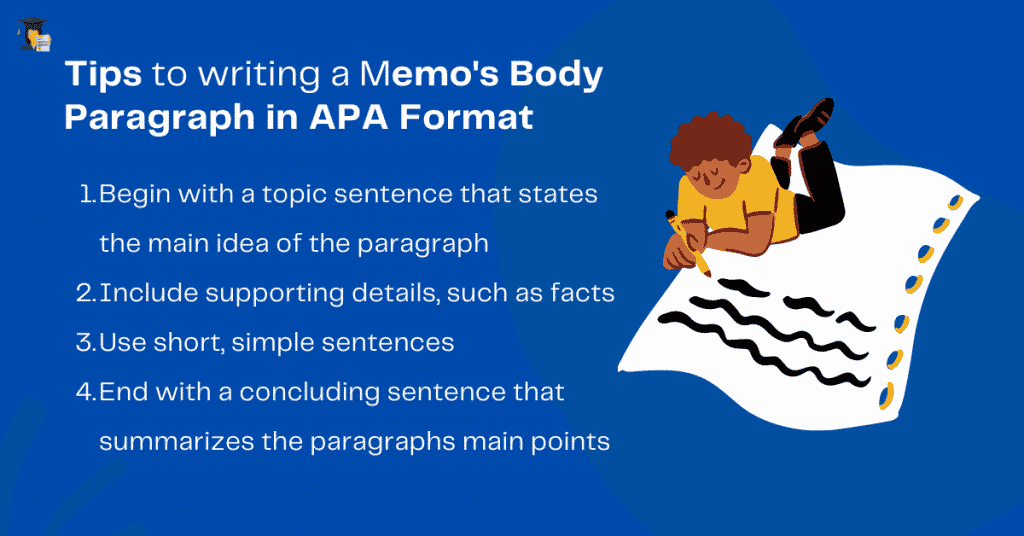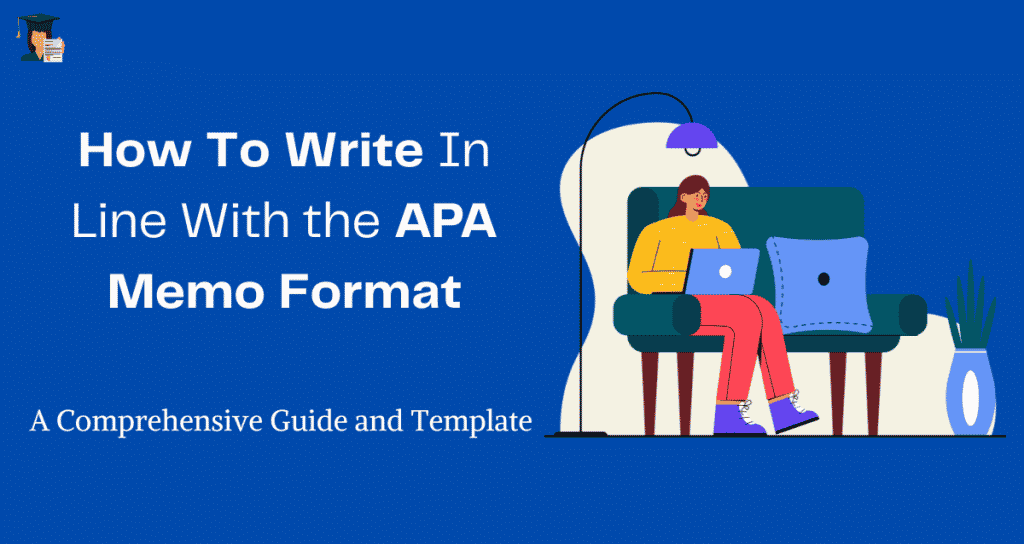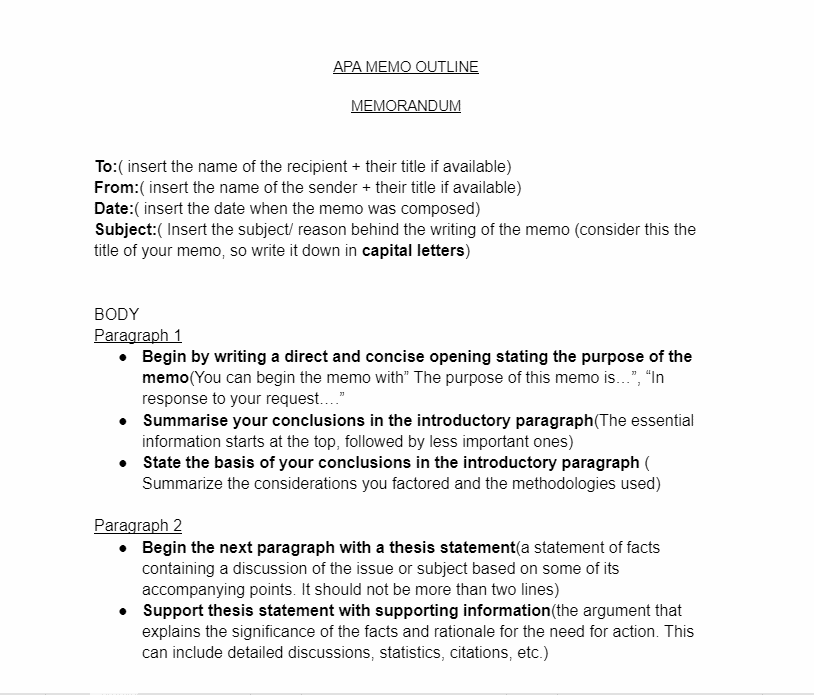In the world of academia, memos are an essential part of daily communication between faculty, staff, and students. Because of their use in academic settings, college students need to know how to write them in APA memo format. It can be a daunting task which is why we offer our affordable and professional writing services to those short on time or not confident about the task.
What is a memo? A memo is a short, formal document typically used to communicate specific information within an organization. It can provide instructions, announce changes, or relay information.
So what exactly is the APA memo format? American Psychological Association format is a type of formatting used in business and academic settings. The format dictates how information is in a memo, including the header, salutation, body, and closing. The format helps to make memos easy to read and understand.
This article will discuss the basics of writing a memo in APA format. Let us get started!
Types of Memos
Now that you have a basic understanding of a memo, we can introduce you to the different types of memos and their different purposes.
They include:

Direct Memo
A direct memo provides information or instructions to a specific audience. A direct notice is written more formally and follows the APA memo format. When writing a direct memo, clearly state the memo’s purpose in the opening paragraph. The body of the notice should then provide details on the issue at hand, and the closing paragraph should summarize the main points of the directive. Following these simple guidelines ensures that your direct memo is clear, concise, and easy to read.
Informative Memo
As the name suggests, an informative memo provides information about a particular topic. It might include new company policies, work procedure changes, or upcoming project updates. An informative notice typically follows the same format as any other memo, with a heading that includes the date and recipient’s name, followed by a brief message. However, the body of an informative notice is typically longer than other types of memos, as it must provide enough detail to explain the memo’s purpose. It is essential to be clear and concise when writing an informative directive. Use simple language and avoid jargon wherever possible. Bullet points can break up longer paragraphs, making the information easier to digest. Furthermore, an informative memo should be formatted according to APA style guidelines.
Persuasive Memo
A persuasive memo is a type of memo used to convince the reader toward a certain action. To do this, you will need to present your argument clearly and logically. You will also need to support your idea with evidence. Persuasive memos can be an effective way to get your point across. However, it is essential to remember that the goal is to persuade, not force, the reader to take action.
Confirmation Memo
A confirmation memo is used to confirm details or arrangements made verbally. This memo type is commonly used in business settings to confirm meetings, appointments, and other agreements. Confirmation memos are brief and to the point and follow a traditional memo format.
In most cases, confirmation memos are written in APA style, including a header with the sender’s name and contact information, the date, and the recipient’s name and contact information. The body of the memo includes a brief description of the arrangement confirmation, date, time, and meeting location. It ends with a courteous closing, such as “Thank you for your time” or “I look forward to hearing from you.”
Suggestive Memo
A suggestive memo is a type of memo that emphasizes a proposed solution to a problem or issue. Its purpose is when small-scale changes prove essential in a business setting. Suggestive memos usually follow the format outlined in the APA Style Guide, including a heading, introduction, body, and conclusion. The author includes their name, title, and contact information in the header. The introduction briefly states the problem or issue that the memo will address. The body of the memo presents the proposed solution and any supporting evidence or rationale. The conclusion outlines any next steps or action items. Suggestive memos often end with a call to action, such as “I suggest you implement this change by X date.” Overall, suggestive memos are a helpful tool for proposing solutions to problems or issues concisely and professionally.
Parts of a Memo
There are vital components of a memo to identify as a student, and they include:
The Heading
A memo’s heading should include the word “memorandum” at the top, centered on the page. The header should also include the memo’s date, sender, and the recipient(s). Where more than one recipient is present, they are listed alphabetically with a semicolon between each name. For example:
MEMORANDUM
Date: January 1, 2020
To: John Smith; Jane Doe;
From: XYZ Corporation
Re: ABC Project Update
The heading of a memo in APA format typically includes four elements: the word “memorandum,” the date, a list of recipients’ names, and finally, the sender’s name. The heading may also include a subject line beneath the sender’s name. The subject line should be brief and describe the purpose of the memo. For example: “ABC Project Update.” In APA format, the sender’s name is included on the left-hand side of the page, aligned with the date, while the recipients’ name appears on the right-hand side. If there is more than one recipient, they should be listed alphabetically with a semicolon between each word.
The Opening
In APA memo format, the opening part of the memo should include the date, a to line, a from the line, and a subject line. The date corresponds to the day on which the sender wrote the notice. The ‘to’ line includes the name and title of the person the memo addresses. The ‘from’ line consists of the name and title of the person who wrote the memo. The subject line briefly states the purpose of the directive. For example, “Subject: Update on Employee Safety.” Following these lines, there should be a blank space before the body of the memo begins.
The Body
The body of a memo is where you will provide the details of your message. When writing the body of a notice, it is essential to keep your language clear and concise. You can use headings and subheadings to help organize your thoughts and make your memo easier to read. APA recommends using mixed case (that is, both upper- and lower-case letters) for headings and subheadings (for example, Section 1: Overview).
The Conclusion
The concluding part of a memo should summarize the main points of the note and restate the purpose for writing it. This section should be brief, clear, and direct. For example, suppose the memo aimed to inform employees of a change in company policy. In that case, the conclusion could restate the new policy and encourage employees to review the attached documents for more information. The conclusion should be aligned with the opening statement in APA memo format. If the opening states the memo’s purpose in one sentence, the conclusion should also note the purpose in one sentence. By keeping the conclusion concise and focused, you can ensure that your readers will walk away with a clear understanding of what they need to do next.
Referencing a Memo
Referencing a memo follows the same basic steps as referencing any other document type. Below are the steps towards referencing a notice:
Author Of the Memo
When referencing the author of a memo, you should include the author’s name and the memo’s date in parenthesis. For example, (Smith, 2020). You should also include the page number in parenthesis if referencing a specific memo section. For example, (Smith, 2020, p. 10). You should include the author’s name, publication date, and URL if you are referencing an online memo. For example, (Smith, 2020, https://www.example.com/memo).
Recipient Of the Memo
When referencing a memo recipient, you should use their full name and title. For example: “Dear Mr. Smith.” If you are unsure of the person’s gender, you can use their full name and title followed by their company name. For example: “Dear Mary Doe, CEO of XYZ Company.” If you are referencing more than one person, you can use their full names or titles followed by “and Company.” For example: “Dear John and Jane Doe.” Thank you for taking the time to read this memo. I hope that you found it helpful.
The Date
If you are referencing a specific date in the body of the memo, you can either write out the full date (e.g., January 1, 2000) or use a shortened version (e.g., 1/1/00).
The Record Creator
When referencing the record creator in a memo, you should include their full name and title. You can add the specific department if you know the one they work in.
For example:
To Whom It May Concern,
I am writing to request the records of John Smith, CEO of ABC Corporation.
Thank you for your time,
Sincerely,
[Your Name]The Record Title
To reference the title, include the author, date, and page number in parenthesis. For example, if you were referencing a memo by John Smith on March 5, 2020, you would write: “John Smith’s memo (Smith, 2020, p. 5)”. If you were referencing the title of a book, you would write: “The title of the book is ‘The Cat in the Hat’ (Dr. Seuss, 1957)”.
Archive’s Information
When referencing a memo in the archive, you should include the following information: the author of the directive, the date it was written, the subject of the memo, and the issue number. For example, if you were referencing a note by John Smith on December 3, 2020, about the topic of “How to reference a memo,” you would include the following information: Smith, John. December 3, 2020. “How to reference a memo.” Issue number. It will help others quickly find the relevant information in the archive.
Series Number
The series number of a memo is referenced by including the number in parentheses after the notice is mentioned. For example, referencing memo #456, you would write “(456).” It shows that you are referencing a specific memo in a series rather than just referencing the series as a whole. If referencing more than one memo in the same series, you can include both numbers in parentheses, separated by a dash. For example, referencing memos #456 and #457, you would write “(456-457).” By including the series number in parentheses after referencing a memo, you can ensure that your reader knows which specific notice you are referencing.
Box/ Folder Number
When referencing the folder number of a memo, it is essential to include the full path to the folder. For example, if the folder is located at C:/Documents/Memos, the referencing statement would look like this: “You can find the memo in folder C:/Documents/Memos.” It is also possible to reference a memo by its unique identifier. To do this, you must include the identifier in square brackets after the full path to the folder. For example: “The memo can be found in folder C:/Documents/Memos [ID#1234].”
Location Number
This location number is generally written as “LN,” followed by the actual number. So referencing the location number of a memo would look something like this: LN47.
Location numbers are significant because they help anyone referencing a particular memo to be able to find it quickly and easily. In a busy office environment, time is often of the essence, so being able to reference a location number can save precious minutes (or even hours).
Writing in APA Format Basics.
This guide will show you how to format APA memos in six basic steps:
1. Use a standard business letter format for your APA memo. Include the date, recipient’s name and address, and your name and address at the top of the memo.
2. Begin the body of your memo with a brief introduction. In the introduction, provide an overview of the memo’s purpose and relevant background information.
3. Present your main points in the body of the memo. Be clear and concise in your writing, and use headings and subheadings to organize your thoughts.
4. Use APA citations when referencing outside sources in your memo. Include a reference list at the end of the directive if you have used any references.
5. Conclude your memo with a summary of your main points and any recommendations for further action.
6. Proofread your memo carefully before sending it to ensure it is free of errors.
These simple APA formatting guidelines will help ensure that your memos are professional and easy to read.
Writing a Memo in APA format.
When writing a memo in APA format, there are a few things to remember. APA memo format is particular, and APA formatted memos have a specific appearance.
Heading
The heading provides the recipient with all the necessary information about the memo author, when it was written, and what it entails. In APA memo format, the heading should include the following information in this order:
- To: The name(s) of the person(s) or department you are writing to
- From: Your name and title
- Date: The date you are writing the memo, written out in full (e.g., January 1, 2020)
- Subject: A brief description of the purpose of the memo
For example:
To: John Smith and Jane Doe
From: Mary Jones, Manager
Date: September 3, 2020
Subject: Meeting Request
Body

The body of the memo should be clear and concise and include all relevant information. Here are some tips on how to write a memo body paragraph in APA format:
- Begin with a topic sentence that states the main idea of the paragraph.
- Include supporting details, such as facts, statistics, and quotes, to back up your main idea.
- Use short, simple sentences. Avoid using jargon or technical terms
- End with a concluding sentence that summarizes the main points of the paragraph.
By following these tips, you can ensure that your memo body paragraph is informative and well-organized.
Conclusion
The APA conclusion paragraph should still include a summary of your memo’s main points and recommendations. However, you should follow APA-specific guidelines when writing your memo conclusion paragraph. Firstly, APA memos typically do not exceed two pages in length. As such, your conclusion paragraph should be concise and to the point. Secondly, write all APA memos in Times New Roman 12-point font. Thirdly, APA memos should have 1-inch margins on all sides. Finally, APA memos should be double-spaced. Following these simple guidelines will help ensure that your APA memo conclusion paragraph is correctly formatted.
APA Format Referencing
APA in-text citation is done by providing the author’s last name and the date of publication in parentheses after the relevant piece of information from the source. For example, if you were to refer to a statistic from a recent study on APA format, you would write “(Smith, 2020).” If there are two authors, you will write “(Smith & Jones, 2020).” While for three or more authors, you will write “(Smith et al., 2020).” If the author’s name is not given, you will write “(Anonymous, 2020).” The date is always written in full (e.g., June 6, 2020). APA in-text citation is just one part of APA format referencing. For more information on APA format referencing, please see the APA Style Guide.
In Conclusion
So there you have it! For every college student, memo writing is essential for their scholarly studies. With the guidelines we have provided on APA format for a memo, you are well on your way to writing and understanding top-notch memos.
Thanks for reading! We hope this article was helpful. Let us know what your thoughts are in the comment section down below. You need bright, talented writers today if you want to succeed. We Bright Writers can help you find the best writing talent and the tools you need to get your message out there. Place your order now, and let us show you how great writing can make a difference in your school work.

Is there an APA format for a memo?
Yes, there is an APA format for a memo. A memo is normally a page or two long. It is single-spaced and left-justified.
What should be included in a memo?
A memo should include the following:
- The purpose of the memo.
- The context of the problem.
- The resolution of the problem
- The conclusion of the memo.
What are the four main parts of a memo format when addressing it?
Heading.
Opening.
Summary.
Conclusion.




